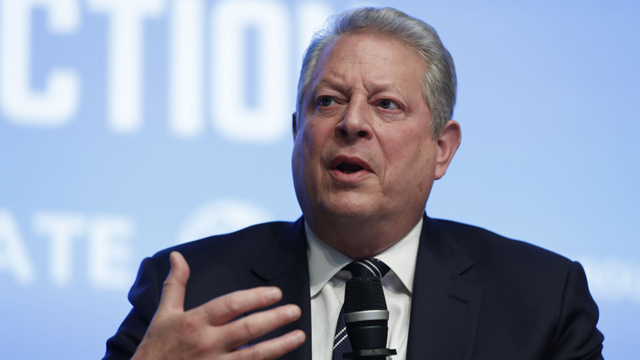While his government dismantles environmental laws and sacks climate scientists, Gore’s mission of a lifetime continues.

Still talking… Al Gore in 2017. PHOTO AP
Al Gore is the great optimist of the global movement for climate action.
While warning about the dangers of global warming, the former US vice-president has also continued to spruik solutions, from the level of individuals all the way up to big corporations and governments.
Last week’s “24 hours of reality” broadcast – the seventh of this annual event – brought more messages of hope. Against the depressing backdrop of a climate change denier in the White House, this year’s effort was admirable indeed.
Bright ideas and solid achievements abounded: solar panels on roads, over canals and above disused coal mines, solar technology discoveries enabling ever-cheaper rollout of panels, previously unheard-of wind turbine efficiency, innovations in wave energy and large-scale battery technology.
But the most memorable part of the broadcast was the work of grass-roots activists across all continents and cultures. In living spaces, classrooms and community gathering places people are plotting their pathways to resilience, and then getting out and putting it into practice.
As Gore has said repeatedly, climate change is not a political problem but a human problem. He has laid out the gravity of our predicament and the need for urgent action, but also makes a strong case for renewed effort at all levels and in all segments of society. He doesn’t give up.
Gore has been a climate action advocate for 30 years. As vice-president under Bill Clinton he was the focal point for US government climate policy, and since his electoral defeat by George Bush has campaigned ceaselessly to raise awareness and galvanise action everywhere.
It became something more than a personal crusade when his documentary An Inconvenient Truth became a global sensation in 2006. In that year he came to Australia in the first of many visits to foster and help train volunteer advocates for action.
No-one can yet say that Gore’s effort has paid off. There have been too many stumbles and U-turns. But his persistence, experience and ability to move seamlessly from the humblest settings to halls of power have been of inestimable value in keeping open essential lines of communication.
His optimism is reinforced by humanity’s often-dazzling cleverness, against which no problem seems too intractable. Breakthrough technologies that seem to defy what’s possible are turning up increasingly often. It’s impossible to keep up.
For instance, distributed energy is now taking on a whole new meaning. As politicians fuss about ageing coal power, in prospect now are roof panels that combine solar energy capture and storage, and flexible capture/storage devices that can be built into hats or clothes.
Against such cheering developments are many reasons to be pessimistic, all underlined by Gore’s dictum that climate change is a human problem. We can be smart, but we can also be stupid, lazy, obdurate, easily diverted, or simply stuck in old habits.
A recent Australian study of climate responses from 2005 to 2015 of five big Australian corporations, in media, finance, insurance, energy and manufacturing, found that after initial fanfare, promises to act on carbon emissions and other climate imperatives came to almost nothing.
As described by the authors – Christopher Wright and Daniel Nyberg, of the Universities of Sydney and Newcastle – the study explains how “grand challenges” get converted over time into “the mundane and comfortable concerns of ‘business as usual’.”
Comfortable maybe, but for how long? The connection between climate change and extreme weather is getting stronger with each passing year, and the risks attached to inaction rise with it.
While the US administration is busy sacking climate scientists, promoting coal and dismantling emission abatement laws, having withdrawn from the global climate agreement, the country of Trump and Al Gore continues to endure a horror year of hurricane, flood and fire.
Three months after Hurricane Harvey dumped unprecedented amounts of water on Texas, most of the state is now either abnormally dry or officially in drought. Seven of California’s 10 largest wildfires on record have occurred since 2002. The state’s average fire season is now well over two months longer than in 1970, and the area of land burned annually in western US has doubled since 1984.
Everyone wonders whether human-induced climate change is behind extreme weather, and science agrees it is a big contributor. But the moment the topic is raised it gets shouted down, because “now is not the time to talk about climate”. Which begs the question, when is the time?
Such pointless exchanges would not happen if political leaders were fully attuned to what science is saying about climate change. Yet despite Gore’s best efforts to get the message out, politicians in authority both in the US and here continue to turn their backs.
Al Gore turns 70 next year. Progress remains elusive, but still he feels compelled, as he said in An Inconvenient Truth all those years ago, to travel the world, meeting after meeting, and keep talking. That takes exceptional grit and faith in humanity, for which I salute him.
